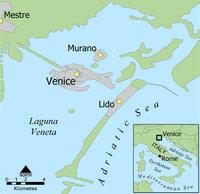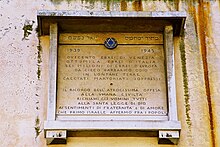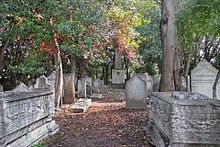| This article needs additional citations for verification. Please help improve this article by adding citations to reliable sources. Unsourced material may be challenged and removed. Find sources: "History of the Jews in Venice" – news · newspapers · books · scholar · JSTOR (May 2011) (Learn how and when to remove this message) |

The history of the Jewish community of Venice, the capital of the Veneto region of Italy, has been well known since the medieval era.
Medieval history
The Third Council of the Lateran forbade and excommunicated any Christian who lives with a Jew or a Muslim. Over the centuries that followed, this translated into occasional European legislation to segregate Jews in their lands.
Despite alternating moments of "permission" and "prohibition", the number and importance of Jews in Venice grew considerably. On March 29, 1516, Doge Leonardo Loredan and the senators of the Republic of Venice enacted a decree to formally isolate the Jews of Venice.
Venetian Ghetto
| This section needs additional citations for verification. Please help improve this article by adding citations to reliable sources in this section. Unsourced material may be challenged and removed. (August 2022) (Learn how and when to remove this message) |

 Jewish Wedding and A circumcision, Venice, c. 1780, by Marco Marcuola
Jewish Wedding and A circumcision, Venice, c. 1780, by Marco Marcuola
Beginning in 1516, the Republic obliged the Jews to live in an area of the city where the foundries, known in Venetian as geto, had been situated in ancient times, to wear a sign of identification and to manage the city's pawnshops at rates established by La Serenissima. Separated into two sections, ghetto vecchio and ghetto nuovo, the Venetian ghetto was home to about 700 Jews in the year 1516. Many other onerous regulations were also included, in exchange for which the Community was granted the freedom to practice its faith and protection in the case of war. Another regulation that existed in reference to the Venetian ghetto was the restriction to non-Venetian Jewish merchants who were wanting to work in Venice. This restriction originated in 1541. There was little to no accommodations for Jewish merchants traveling to Venice in the existing ghetto and it was a requirement for all Jews to live in the Venetian Ghetto even if it was temporary. Under the permission and discretion of government officials, Jewish merchants living in Venice temporarily were allowed to move into the ghetto vecchio under the guise that none of them would move to Venice permanently or bring their families.
The first Jews to comply with the decree were Ashkenazi from Central Europe. They used to melt metal, getto in Venetian, as their one in two options of income. The other choice was selling secondhand items and clothing. When the Germans came, their guttural pronunciation changed the Venetian term from getto into ghetto, creating the word still used today to indicate various places of emargination. The ghetto was closed from 6 p.m. every night to 12 p.m. the next day. The boats of the Christian guards scoured the surrounding canals to impede nocturnal violations. This is how Europe's first ghetto was born. Known as Scole, the synagogues of the Venetian ghetto were constructed between the early-16th and mid-17th centuries. (The word scole (σχολή) can be compared with the Yiddish shul, the German Schule, the Italian scuola, or the English school.) Each represented a different ethnic group that had settled here stably and obtained a guarantee of religious freedom: the German and Canton Scole practiced the Ashkenazi rite; the Italian, the Italian rite and the Levantine and Spanish, the Sephardic rite. Despite a few later interventions, these synagogues have remained intact over time and testify to the importance of the Venetian ghetto. The unusual tall buildings found here were divided into floors of sub-standard height, demonstrating how the density of the population had increased over the years.
Modern era
After the fall of the Venetian Republic in 1797, Napoleon decreed the end of the Jewish segregation and the equalization of the Jews to other citizens. This provision became definitive when Venice was annexed to the Italian Kingdom.
Rise of fascism and the Holocaust

In September 1938, the promulgation of the fascist racial laws deprived the Jews of civil rights, and the Jewish community entered a difficult period under the leadership first of Aldo Finzi and subsequently (from June 1940) of Professor Giuseppe Jona.
In September 1943, Italy changed from being an ally of Nazi Germany into an occupied country, and the Nazis started a systematic hunt for Jews in Venice as in other Italian cities. On 17 September, Professor Jona committed suicide rather than hand over to the German authorities a list of Jewish community residents.
In November 1943, Jews were declared 'enemy aliens' in accordance with the manifesto of the Italian Social Republic, to be arrested and their property seized. Although some Jews managed to escape to neutral Switzerland or Allied-occupied southern Italy, over two hundred were rounded up, most between 5 December 1943 (when approximately 150 were arrested) and late summer 1944. They were held at the city's Marco Foscarini college, the women's prison on Giudecca, the prison at Santa Maria Maggiore and subsequently at Fossoli concentration camp, before being deported, in most cases, to Auschwitz-Birkenau in 1944. Those arrested later in 1944 included some 20 residents of a Jewish convalescence home, the Casa di Ricovero Israelitica (including Venice's Chief Rabbi, Adolfo Ottolenghi, who chose to follow the fate of his fellow deportees) and 29 from a Jewish hospital. Most of those arrested in the summer of 1944 spent time incarcerated at Risiera di San Sabba concentration camp, Trieste. Although a figure of two hundred and five Jewish deportees from Venice between November 1943 and August 1944 is often quoted, one source give the higher figure of 246, which includes those deported to Trieste, some of whom died there, and a smaller number of arrests after this point up until the end of the war. Only 8 Jewish residents of Venice emerged from the death camps. The 1938 Jewish population of Venice (2000) was reduced by the war's end to 1500, or in some sources 1050.
A memorial plaque to Venice's Holocaust victims can be seen in Venice's Campo del Ghetto Nuovo, close to a memorial sculpture by Arbit Blatas. Chief Rabbi Adolfo Ottolenghi is also commemorated there in a memorial tablet, as well as by a memorial woodland at Mestre.

Today

The former Ghetto is now a lively and popular district of the city where the religious and administrative institutions of the Jewish Community and its five synagogues persist.
Library
The Renato Maestro Library and Archives was opened in the Venetian Ghetto via private funding in 1981.
Its main goal is to make a wide range of resources on Judaism, Jewish civilization, and particularly the history of Italian and Venetian Jews, accessible to a vast public, and to promote knowledge of all these subjects. The library owns a large collection of documents and publications on the Jewish community dating from the 17th century.
The catalogue of modern books numbers 8,000 titles in Italian, English, French, German, and Hebrew. The Catalogue of Ancient Hebrew Books includes 2,500 volumes (16th–19th century). The library subscribes to thirty-five periodicals and several others, totaling one hundred, are available.
Language
The Jewish community of Venice had it own language, a dialect of Judeo-Italian known as Judeo-Venetian. Though it is now extinct, it is attested through various writings and was based on Venetian with many Hebrew loanwords.
Museum
The Jewish Museum of Venice is situated in the Campo of the Ghetto Novo, between the two most ancient Venetian synagogues. It is a small but rich museum founded in 1953 by the Jewish Community of Venice.
The precious objects shown to public, important examples of goldsmith and textile manufacture made between the 16th and the 19th centuries are a lively witnessing of the Jewish tradition.
The first room of the museum is dedicated to silver wares reminding the most important Jewish festivities starting from Shabbat (windows 1 and 2).
With the objects displayed in window 3 the Days of Repentance, Rosh Ha Shanà and Yom Kippur, opening the Jewish year, are introduced.
The display of festivities continues with Channukkà (the Inauguration), a festivity during which nine-branch-lamps are lighted at home and in the synagogue (every day a further lamp is lit). In windows 5 and 6 you can admire several examples of these lamps).

The festivity of Purim happens about at the end of winter and it is a feast of joy during which Meghillat Ester is read (the scroll of handwritten manuscript where this story is told is on display on window 8.
Pesach (Passover), feast of unleavened bread, of spring and of pilgrimage, is a joyful feast commemorating the liberation from slavery in Ancient Egypt. A big tray for the Seder di Pesach is on display on window 7.
Place of honour, in the first room of the museum, is given to the Sefer Torah (Scroll of Divine Law). It is a manuscript, executed in a ritual way, of Pentateuch. The Scroll of Divine Law is covered with a mantle (Meil), a crown (Atarah), symbol of the royalty of the Lord.
Often a silver dedicatory plaque (Tass)(window 11) is hanged over the Scroll of Divine Law. In many cases the inscription of the Ten Commandments or the title of the passage read in a given solemnity is carved in the plaque.
The Scroll of Divine Law, covered with the Meil and the Atarah is kept inside the synagogue, in the 'Aron Ha Kodesh (Ark of Holiness). To help the reading of the scroll a little decorated silver stick, ending with a little hand is used (Yad). You can admire many examples of this on window 11.
The second room of the museum is instead mostly dedicated to textile manufacture, related of course to Jewish tradition. You can find different examples of Meil and other precious coverings used to decorate the Torah, but you can particularly find beautiful examples of Parokhet, curtains to cover the doors of 'Aron Ha Kodesh.
Besides this room keeps important witnessing about Marriage and Birth: several Ketubboth, the stereotyped form of wedding contract, extremely relevant, above all in the past times, for the protection of woman in case of dissolution of marriage, allowed by Jewish tradition; and a 1779 set of clothes for the circumcision, rite of basic importance that shows the entrance of the new-born Jewish boy in the alliance stipulated by the Lord with Abraham and his descendants.
Cemetery

The Republic of Venice gave the Jews the possibility to create a cemetery of their own in 1386, giving them a non-cultivated piece of land in St. Nicholas of Lido, whose property was however claimed by the monastery at Lido di Venezia.
At the end of the disputation with the monks the cemetery, starting from 1389, was used with no interruptions and later made bigger reaching its top expansion in 1641.
After this date, the widening of system of fortification of the Lido, wanted by the Serenissima Republic to defend itself from the Ottoman Empire, brought to a slow but constant reshaping of the cemetery spaces southbound, so that in 1736 the "University of Jews" was forced to buy a piece of land bordering it.
The fall of the Venetian Republic, the foreign occupations and the consequent vandalism, as well as the atmospheric agents brought to the disappearance of many monuments and to the ruin of the Jewish cemetery.
In the 19th century, because of the project to make the Lido of Venice healthier and competitive, part of the Cemetery (now belonging to the state) was expropriated and bound to other uses.
Later, some attempts to restore it began, without outcome and in 1938 (promulgation of Italian Racial laws) the cemetery was definitely abandoned.
In 1999, thanks to the collaboration of public and private enterprises, both from Italy and abroad, restoration of Antico Cimitero Ebraico di Venezia has begun; many memorials have been saved and classified more than 1000 of them which can be dated between 1550 and the early 18th century.
See also
- Venetian Ghetto
- History of the Jews in Italy
- History of the Jews in Calabria
- History of the Jews in Livorno
- History of the Jews in Naples
- History of the Jews in the Roman Empire
- History of the Jews in Sicily
- History of the Jews in Trieste
- History of the Jews in Turin
- The Merchant of Venice
References
- "From Geographical Realia to Historiographical Symbol". faculty.history.umd.edu. Retrieved 15 August 2024.
- Nightingale, Carl H. (2012-05-01). Segregation: A Global History of Divided Cities. University of Chicago Press. ISBN 9780226580777.
- Ravid, Benjamin (1976). "The First Charter of the Jewish Merchants of Venice, 1589". AJS Review. 1: 187–222. JSTOR 1486343.
- Fortis, Umberto (2008) Venice Ghetto - Holocaust Period. Jewish Virtual Library
- Zuccotti, Susan (1996) The Italians and the Holocaust: persecution, rescue and survival. Lincoln: University of Nebraska
- Fortis, Umberto (2008) Venice Ghetto - Holocaust Period. Jewish Virtual Library
- Fortis, Umberto (2008) Venice Ghetto - Holocaust Period. Jewish Virtual Library
- Fortis, Umberto (2008) Venice Ghetto - Holocaust Period. Jewish Virtual Library
- Weiner, Rebecca The Virtual Jewish History Tour, Venice The Virtual Jewish History Tour: Venice
- Fortis, Umberto (2008) Venice Ghetto - Holocaust Period. Jewish Virtual Library
- The Encyclopedia of Jewish Life Before and During the Holocaust: Volume 3 - 'Seredina-Buda to Z' (Shmuel Spector, Geoffrey Wigoder (eds). New York: New York University, p 1385
- Bosco di Mestre Archived 2011-07-27 at the Wayback Machine (in Italian)
- "Judeo-Italian". Jewish Languages. Retrieved 2023-12-25.
External links
- Official website of the Jewish Community of Venice
- Kosher in Venice
- Jewish Ghetto English site
- Venice Eruv Map - Jewish Community of Venice
- Jewish Library-Archive "Renato Maestro"
- Chabad of Venice
- The Jewish Community of Venice Archived 2020-08-10 at the Wayback Machine, The Museum of the Jewish People at Beit Hatfutsot
- Venice Center for International Jewish Studies